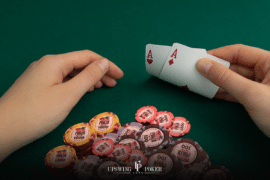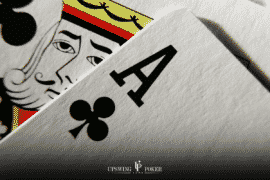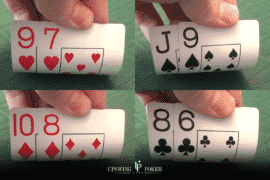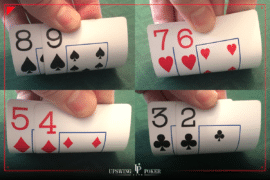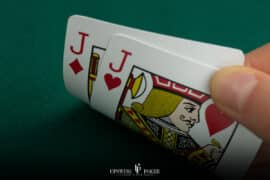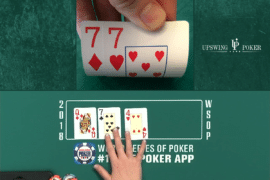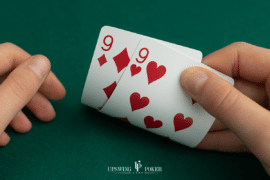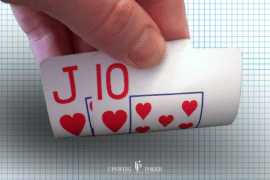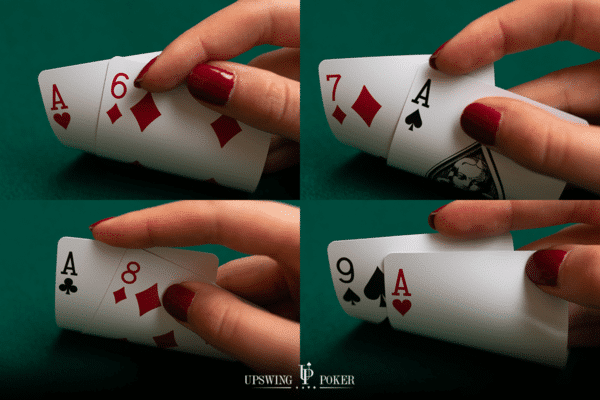
How to Play Middling Offsuit Aces in Cash Games
Middling offsuit Aces include A6o, A7o, A8o, and A9o.
Playing these hands correctly can be tough, even for experienced players. They aren’t super strong hands, but they’re still worth playing in some situations.
If you’re always folding middling offsuit Aces, you’re leaving money on the table. However, it’s arguably an even bigger mistake to play them too often. This article will help you reach the sweet spot in between.
Here’s what’s covered:
- How to Play Middling Offsuit Aces Preflop
- How to Play These Hands Postflop (as the Preflop Raiser from the Button)
- Rainbow Disconnected Flops
- Rainbow Connected Flops
- Disconnected Flops with a Flush Draw
- Connected Flops with a Flush Draw
- Paired Flops
Let’s dive into it!
How to Play Middling Offsuit Aces Preflop
Middling offsuit aces (A9o-A6o) are pretty weak hands, which is reflected in the way that they should be played preflop.
Here are the table positions for your reference:
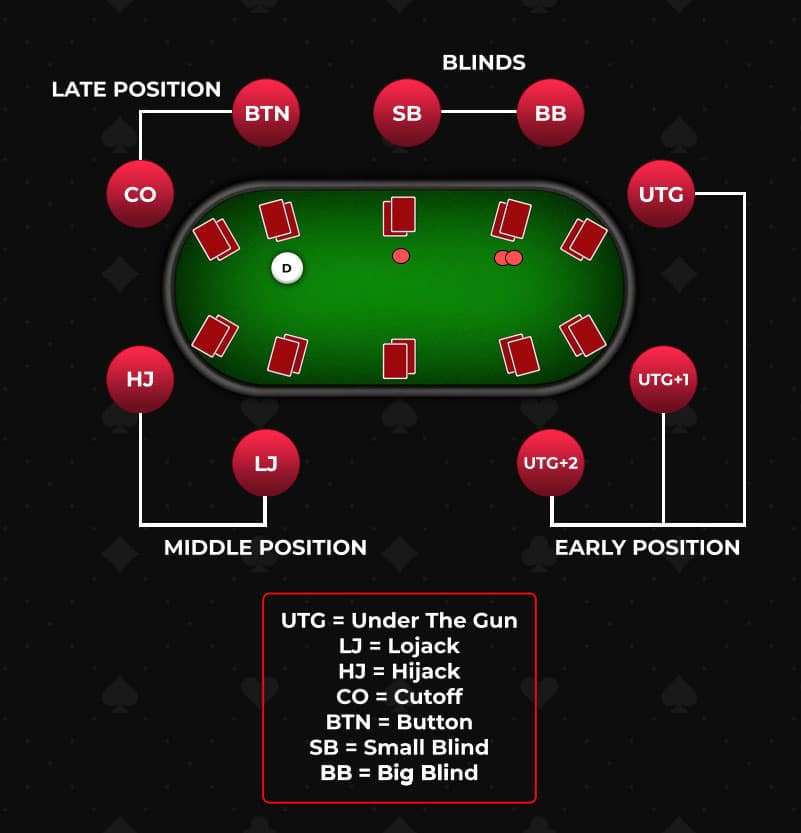
Unopened Pots
Now, let’s break down how offsuit Aces should be played from each position in an unopened pot:
- UTG through the Hijack – All middling offsuit Aces should be folded every time.
- From the Cutoff – A9-offsuit and A8-offsuit can be raised.
- From the Button – All middling offsuit Aces can be raised (along with A5o and A4o).
- In the Small Blind – all offsuit Aces can be raised.
Simple enough, right?
Versus a Raise
The value of middling Aces drops drastically when facing a raise.
If someone raises in front of you, you should fold middling offsuit Aces every single time except when you are in the Big Blind.
When you’re in the Big Blind facing a raise, you should:
- Vs Lojack or earlier – Fold every time.
- Vs Hijack – Call A9-offsuit (folding all lower offsuit Aces).
- Vs Cutoff – Call A9-offsuit and A8-offsuit (fold all lower offsuit Aces).
- Vs Button – Call all middling offsuit Aces (as well as A5o and A4o).
- Vs Small Blind – Call A9-offsuit through A5-offsuit (and mix 3-bets with lower offsuit Aces).
This advice assumes your opponent used a relatively standard open size (2-3 big blinds). If your opponent goes for a larger raise size, you should play even tighter.
How to Play Middling Offsuit Aces Postflop (as the Preflop Raiser from the Button)
When you find yourself playing a middling offsuit Ace postflop, you will most frequently be doing so from the Button. So, that will be the focus of this section. Keep in mind that the general concepts apply to other positions as well (like if you raised from the Cutoff).
The most important factor to consider when playing these hands is flop morphology (aka board texture).
These are the flops covered in this section:
- Rainbow disconnected (K♥ 8♠ 4♦)
- Rainbow connected (K♥ 9♠ 4♦)
- Two-tone disconnected (Q♠ 7♠ 4♥)
- Two-tone connected (Q♠ 9♠ 4♥)
- Paired (9♠ 9♥ 5♦)
There are obviously more types of flops, but these should cover the basics. So, let’s explore how these middling offsuit Aces should be played on each of these example flops.
Rainbow Disconnected Flop
Let’s begin with an example of a rainbow disconnected flop: K84 rainbow.
Take a look at a simulation I’ve done with “GTO” preflop ranges:

On these types of boards, when there is a high card and the next card is disconnected, the preflop raiser has a big range advantage of around 10%.
Because of this range advantage, the optimal c-betting strategy is extremely aggressive and for a small size.
If you look closely at the A9-offsuit, specifically, you will see that the solver checks with it the majority of the time. But, in practice, you can simplify your strategy and bet 100% of the time with A9o, along with the A8-A3o that the solver already bets very frequently.
Rainbow Connected Flops
Now, let’s take a look at another rainbow flop that is a bit more connected flop.
I wanted to pick something that is seemingly very similar to the previous flop, so let’s run a simulation for K94 rainbow.

The same trend is happening here — though you may notice the c-bet frequency actually increased on this slightly more connected flop.
Like on the K84 flop, the preflop raiser has a staggering range advantage on this board (14%). Once again, betting with 100% of your offsuit Ace highs is the best way to go.
Disconnected Flops with a Flush Draw
Next up, disconnected flops with a flush draw (aka two-tone flops).
Let’s take a look at a solution for a Q74 two-tone flop:

You can see a large change in the overall c-betting strategy, including with middling offsuit Ace-highs. Some are betting much more often than others, and there is a good reason for that.
Let’s compare A9o (which is almost only checking) to A6o (which is almost only betting).
The key question to ask when comparing these two hands is: What better hands do you fold out when you c-bet?
Against a small c-bet such as the 33% pot bet the solver uses, the Big Blind will fold with any unpaired Ace high except for those that either contain a spade (giving it a backdoor flush draw) or has a backdoor draw to a broadway straight (AT–AJ).
When you hold A6, you will force folds from A7, A8, and A9 without a backdoor flush draw. When you hold A9, you are only folding out worse or similar Ace-highs. In other words, A6 simply forces folds from a larger number of better hands.
The other consideration is how this hand will play out when you pair your kicker on the turn. If you check back with A9o and the turn is a 9, you will win a bet or two from hands like J9/T9/98 — all of which probably would have folded to a flop c-bet.
The same effect does not happen when you check A6o and hit a 6 for two reasons: your opponent won’t play as many offsuit 6x hands preflop and third pair isn’t as worthy of a value bet as second pair.
Connected Flops with a Flush Draw
Now let’s move on to a two-tone connected flop.
Again, I wanted to pick something close to the previous board: Q94 two-tone. Here’s the PioSolver sim:

Things change here. You may have noticed the darker pink color popping up more often. This signifies that the solver elects to use a bigger bet size (66% of the pot in this case).
It makes logical sense to use bigger bet sizes on such a connected board. There are numerous flush draws, open-enders, and gutshot straight draws that will continue no matter the bet size used. Plus, there’s the fact that the “value” hands are vulnerable to a swift change in equity on many turns (think about how much top pair shrivels up on a turn like the 8♠ or T♠).
Moving over to the subject of (unpaired) middling offsuit Aces, there is a consistent pattern with how the solver plays these hands.
Can you spot it by looking at the combo-by-combo breakdown?



The pattern is clear and consistent: the backdoor flush draw heavily incentivizes a c-bet. This makes sense for a few reasons:
- Every hand with a spade blocks bluff-check raises, which means you will face a raise less often after c-betting with these hands.
- You can continue bluffing very profitably on flush completing turns (because you block flushes and have a flush draw yourself).
- Your hand has an extra 3-4% in equity because of the backdoor flush draw.
So, you should mostly waive the white flag on these flops with middling offsuit Aces. But when you have a flush blocker, you get to turn up the heat.
Paired Flops
Let’s now turn our attention to the last board type of the day: paired flops.
Here’s the solution for 995 rainbow:

On this board, the number of trips in each players’ range is very close to even, but the preflop raiser still holds an advantage because of the overpairs exclusively in his range.
These two factors make motivate the solver to utilize a very aggressive, small c-bet strategy.
You can see that A6 and A7-offsuit are betting nearly 100% of the time, while the A8-offsuit is betting only around 50% of the time. This happens for the same reasons as the Q74 two-tone flop (you don’t force folds from as many better hands).
Against a c-bet, however, the solver check-raises a whopping 30% of the time as the Big Blind. Since very few human opponents will do that, it makes sense to simplify this Button strategy and go for a 100% range c-bet.
Final Thoughts
There you have it. A blueprint for playing these middling offsuit Aces on the vast majority of flops.
That’s all for this article! I hope you learned something new and that you enjoyed reading it, as I had a fun time writing it. As usual, if you have any questions or feedback please let me know in the comment section down below and I will do my best to answer!
Here’s a relevant topic I suggest reading about next: What is Board Coverage & Why Does It Matter?
Till’ next time, good luck, grinders!

